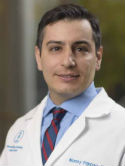A dynamic clinical calculator for estimating conditional recurrence-free survival after total neoadjuvant therapy for rectal cancer and either surgery or watch-and-wait management Journal Article
| Authors: | Weiser, M. R.; Chou, J. F.; Kim, J. K.; Widmar, M.; Wei, I. H.; Pappou, E. P.; Smith, J. J.; Nash, G. M.; Paty, P. B.; Cercek, A.; Saltz, L. B.; Romesser, P. B.; Crane, C. H.; Garcia-Aguilar, J.; Schrag, D.; Gönen, M. |
| Article Title: | A dynamic clinical calculator for estimating conditional recurrence-free survival after total neoadjuvant therapy for rectal cancer and either surgery or watch-and-wait management |
| Abstract: | Importance: The risk of recurrence in patients with locally advanced rectal cancer has historically been determined after surgery, relying on pathologic variables. A growing number of patients are being treated without surgery, and their risk of recurrence needs to be calculated differently. Objective: To develop a dynamic calculator for estimating the probability of recurrence-free survival (RFS) in patients with rectal cancer who undergo total neoadjuvant therapy (TNT) (induction systemic chemotherapy and chemoradiotherapy) and either surgery or watch-and-wait management. Design, Setting, and Participants: This cohort study included patients who presented with stage II or III rectal cancer between June 1, 2009, and March 1, 2015, at a comprehensive cancer center. Conditional modeling was incorporated into a previously validated clinical calculator to allow the probability of RFS to be updated based on whether the patient remained in watch-and-wait management or underwent delayed surgery. Data were analyzed from November 2021 to March 2022. Exposure: TNT followed by immediate surgery or watch-and-wait management with the possibility of delayed surgery. Main Outcomes and Measures: RFS, concordance index, calibration curves. Results: Of the 302 patients in the cohort, 204 (68%) underwent surgery within 3 months from TNT completion (median [range] age, 51 [22-82] years; 78 [38%] women), 54 (18%) underwent surgery more than 3 months from TNT completion (ie, delayed surgery; median [range] age, 62 [31-87] years; 30 [56%] female), and 44 (14%) remained in watch-and-wait management as of April 21, 2021 (median [range] age, 58 [32-89] years; 16 [36%] women). Among patients who initially opted for watch-and-wait management, migration to surgery due to regrowth or patient choice occurred mostly within the first year following completion of TNT, and RFS did not differ significantly whether surgery was performed 3.0 to 5.9 months (73%; 95% CI, 52%-92%) vs 6.0 to 11.9 months (71%; 95% CI, 51%-99%) vs more than 12.0 months (70%; 95% CI, 49%-100%) from TNT completion (P =.70). RFS for patients in the watch-and-wait cohort at 12 months from completion of TNT more closely resembled patients who had undergone surgery and had a pathologic complete response than the watch-and-wait cohort at 3 months from completion of TNT. Accordingly, model performance improved over time, and the concordance index increased from 0.62 (95% CI, 0.53-0.71) at 3 months after TNT to 0.66 (95% CI, 0-0.75) at 12 months. Conclusions and Relevance: In this cohort study of patients with rectal cancer, the clinical calculator reliably estimated the likelihood of RFS for patients who underwent surgery immediately after TNT, patients who underwent delayed surgery after entering watch-and-wait management, and patients who remained in watch-and-wait management. Delayed surgery following attempted watch-and-wait did not appear to compromise oncologic outcomes. The risk calculator provided conditional survival estimates at any time during surveillance and could help physicians counsel patients with rectal cancer about the consequences of alternative treatment pathways and thereby support informed decisions that incorporate patients' preferences.. © 2022 American Institute of Physics Inc.. All rights reserved. |
| Keywords: | adult; cancer survival; treatment outcome; treatment response; aged; middle aged; cancer surgery; major clinical study; histopathology; cancer localization; cancer recurrence; fluorouracil; advanced cancer; cancer growth; cancer risk; systemic therapy; capecitabine; neoadjuvant therapy; cancer staging; multiple cycle treatment; cohort studies; neoplasm recurrence, local; cohort analysis; pathology; cancer center; probability; watchful waiting; tumor recurrence; folinic acid; therapy delay; data analysis; drug infusion; kaplan meier method; neoadjuvant chemotherapy; oxaliplatin; rectal neoplasms; rectum cancer; rectum tumor; induction chemotherapy; recurrence free survival; patient preference; conformal radiotherapy; humans; human; male; female; article; treatment switching |
| Journal Title: | JAMA Network Open |
| Volume: | 5 |
| Issue: | 9 |
| ISSN: | 2574-3805 |
| Publisher: | American Medical Association |
| Date Published: | 2022-09-01 |
| Start Page: | e2233859 |
| Language: | English |
| DOI: | 10.1001/jamanetworkopen.2022.33859 |
| PUBMED: | 36173634 |
| PROVIDER: | scopus |
| PMCID: | PMC9523500 |
| DOI/URL: | |
| Notes: | Article -- Export Date: 1 November 2022 -- Source: Scopus |
Altmetric
Citation Impact
BMJ Impact Analytics
MSK Authors
Related MSK Work



















